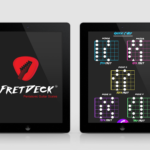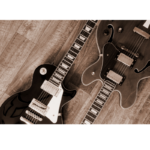Major scales for guitar will unlock the secrets of the fretboard and allow you to improvise across the guitar. These scales form the cornerstone of Western music and are essential for any guitarist’s repertoire. We will examine the structure of major scales and how to apply them to the fretboard. All we need to understand is 7 different notes.
Understanding Major Scales
Before we dive into the practical aspects, let’s establish a solid understanding of major scales. A major scale is a sequence of notes arranged in a specific pattern of whole steps (W) and half steps (H). The formula for a major scale is W-W-H-W-W-W-H. For instance, the C major scale consists of the notes C-D-E-F-G-A-B-C, following this formula.
Learning Major Scales on Guitar
Learning major scales on the guitar involves familiarizing yourself with the scale patterns across the fretboard. The most common way to play a major scale on the guitar is using the CAGED system. This system utilizes five basic chord shapes—C, A, G, E, and D—to map out scale patterns across the neck.
- C Shape: Start with the C major chord shape at the 8th fret and play the scale pattern from there.
- A Shape: Move to the A major chord shape at the 5th fret and play the scale pattern.
- G Shape: Shift to the G major chord shape at the 3rd fret and play the scale pattern.
- E Shape: Move to the E major chord shape at the open position and play the scale pattern.
- D Shape: Finally, use the D major chord shape at the 10th fret and play the scale pattern.
By mastering these five shapes, you can play major scales in any key across the fretboard. Practice each shape individually and gradually connect them to cover the entire neck seamlessly.
Exploring Modes in the Major Scale
Now that you’re comfortable with major scales, it’s time to explore modes. Modes are variations of the major scale, each starting from a different degree of the scale. Understanding modes adds depth to your playing, allowing you to evoke various musical moods and flavors. Here are the seven modes derived from the major scale:
- Ionian Mode (Major Scale): This is the standard major scale, starting from the root note.
- Dorian Mode: Begin on the second degree of the major scale. For example, in C major, play D-Dorian (D-E-F-G-A-B-C).
- Phrygian Mode: Start on the third degree of the major scale. In C major, play E-Phrygian (E-F-G-A-B-C-D).
- Lydian Mode: Commence on the fourth degree of the major scale. In C major, play F-Lydian (F-G-A-B-C-D-E).
- Mixolydian Mode: Begin on the fifth degree of the major scale. In C major, play G-Mixolydian (G-A-B-C-D-E-F).
- Aeolian Mode (Natural Minor Scale): This is the relative minor of the major scale, starting from the sixth degree. In C major, play A-Aeolian (A-B-C-D-E-F-G).
- Locrian Mode: Start on the seventh degree of the major scale. In C major, play B-Locrian (B-C-D-E-F-G-A).
Practical Application and Practice Tips
To incorporate major scales and modes into your playing effectively, here are some practice tips:
- Start Slow: Begin by playing major scales and modes slowly, focusing on accuracy and clarity.
- Use a Metronome: Practice with a metronome to improve your timing and rhythm.
- Play Along with Backing Tracks: Experiment with different musical contexts by playing along with backing tracks in various keys and styles.
- Transpose: Once you’re comfortable in one key, transpose the scales and modes to other keys to expand your musical vocabulary.
- Experiment with Soloing: Use major scales and modes as a foundation for improvisation and soloing over chord progressions.
Conclusion
Mastering major scales for guitar opens up a world of musical possibilities. By understanding the scale patterns, exploring modes, and incorporating them into your practice routine, you’ll develop a deeper understanding of music theory and enhance your playing skills. Remember, consistent practice and experimentation are key to mastering major scales and unleashing your creativity on the guitar. So grab your guitar, dive into the world of major scales, and let your musical journey begin!

Download The FretDeck & Pentatonic Secrets Course!
Download Our Course









